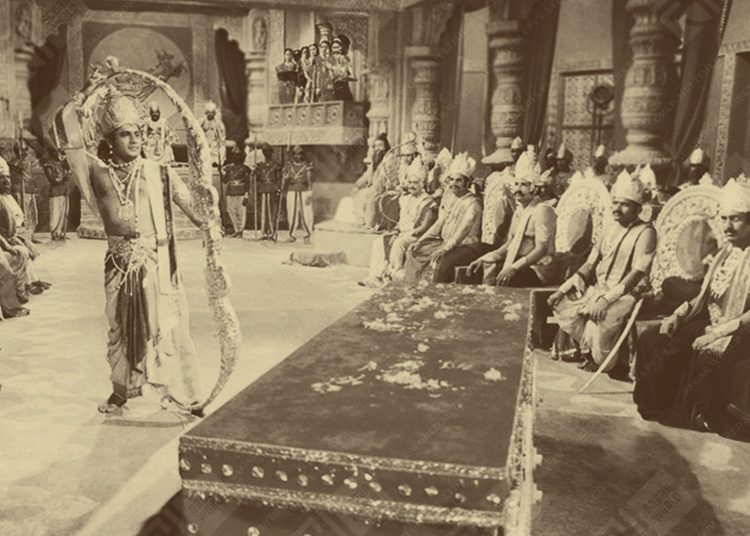(Other names: Rama, Purshottam Ram, Bhagwan Ram, Ram Avatar, Shri Ram)
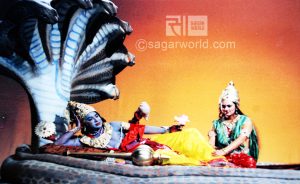
In the Treta Yuga (there are four Yugas according to Hindu mythology Sat (Krita) Yuga, Treta Yuga, Dwapar Yuga and Kali Yuga), Ramkatha, the story of Ram, the eldest son of the king Dashrath and Ayodhya. After King Dashrath organized a Putreshthi yagya (a sacrifice performed for the purpose of having a son),Ram was born to the eldest Queen, Kaushalya.
According to the ancient stories, the demon King of Lanka, Ravan, had acquired a boon from Lord Shiva that he could not be killed by the hands of a deity, demon, demigod or a Kinnar (a demigod with a head of a horse).Due to this boon, Ravan had become fearless and so he had started persecuting the Saints, Sages and righteous men. Even the deities had become terrified of Ravan.
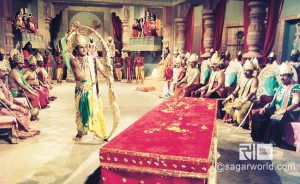
Religion was getting destroyed and injustice was increasing. In this condition, to protect religion and to reduce the sufferings of the righteous, Lord Vishnu took birth at King Dashrath’s house in the form of a human being. In the Vishnu-puran, Ram is said to be the seventh incarnation of Vishnu. Ramnavami or the birthday of Lord Ram falls on the 9th day of the bright fortnight of the month of Chaitra (March-April).
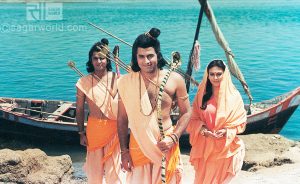
 Dashrath’s family teacher Vashishtha was responsible for Ram’s education. Ram killed the demons that were trying to disrupt the yagya (sacrifice) of Vishwamitra. He went to Mithila to attend the Swayamvar (the choice of husband made by a princess in public) of Sita, daughter of King Janak. There, he broke the Shiv-dhanush (Shiva’s bow) and Sita gave him the nuptial garland.He obeyed his father, and went for an exile of fourteen years, in order to honour the promise that his father had made to queen Kaikeyi. During this period, Sita was kidnapped by Ravan, King of Lanka. Due to this, a great war was fought between Ram and Ravan.
Dashrath’s family teacher Vashishtha was responsible for Ram’s education. Ram killed the demons that were trying to disrupt the yagya (sacrifice) of Vishwamitra. He went to Mithila to attend the Swayamvar (the choice of husband made by a princess in public) of Sita, daughter of King Janak. There, he broke the Shiv-dhanush (Shiva’s bow) and Sita gave him the nuptial garland.He obeyed his father, and went for an exile of fourteen years, in order to honour the promise that his father had made to queen Kaikeyi. During this period, Sita was kidnapped by Ravan, King of Lanka. Due to this, a great war was fought between Ram and Ravan.
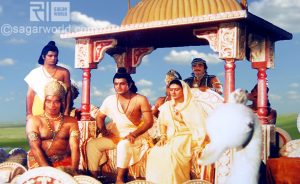
Ravan was killed by Ram during this war. By killing Ravan, Ram made the sages and righteous safe again and reinstalled the glory of religion. On finishing his forest exile, Ram became the king of Ayodhya, and ruled as a protector of his subjects and a dutiful religious king.Ram and Sita are the protagonists in one of the most famous love stories of all time. Sita and Ram are described as being deeply in love and are theologically understood as avatars of Lakshmi and Vishnu respectively.
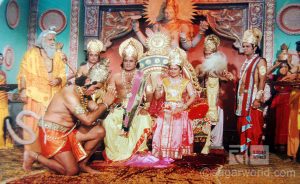
When Ram is banished from the kingdom,he attempts to convince Sita not to join him in a potentially dangerous, and certainly arduous, existence in the jungle, but Sita rejects this suggestion and insists on accompanying him. When Ram orders her not to do so in his capacity as husband, Sita rejects this also, asserting that it was an essential duty of a wife to be at her husband’s side, come good or ill. Ram in turn is assiduously protective and caring for Sita throughout the exile.Ram’s reign was set apart due to the happiness, prosperity, peace, good conduct, and virtues that characterised it. That is why it is one of the best and ideal reigns and so is called ‘RAMRAJYA’.
Ram himself is the ideal of mercy, modest, virtuous conduct, sacrifice and generosity.He became an exemplar of Indian civilization because of his singular virtues and shining character. Ram is paid homage as‘MARYADA- PURSHOTTAM’ in the puranas as he is the perfect man, who maintains dharma with the help of his companions.
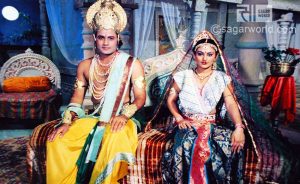
The story of Ram is famous all over India. Except for the demons, all the principal characters of Ramkatha also cherish social ideals and virtues. Ram’s wife Sita was also an ideal wife. His brothers Lakshman, Bharat and Shatrughna were also ideal brothers. Hanuman and Sugriv has been immortalised as an ideal devotee and an ideal friend respectively.
Even the demon family of Ravan had a righteous member: Vibhishan. That is why the ‘RAMAYAN’ is approved as the best epic for depicting social ideals.
History of Ramayna
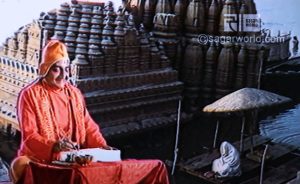
 Apart from India, Ramayana is famous in the countries like Indonesia, Java, Thailand, Myannmar (Burma) and Cambodia. Ramkatha is available in three hundred forms in different languages. In this, the ‘Ramayana’ composed by Valmiki in India and ‘Ram Charit Maanas’, composed by Tulsidas, is the most famous.
Apart from India, Ramayana is famous in the countries like Indonesia, Java, Thailand, Myannmar (Burma) and Cambodia. Ramkatha is available in three hundred forms in different languages. In this, the ‘Ramayana’ composed by Valmiki in India and ‘Ram Charit Maanas’, composed by Tulsidas, is the most famous.
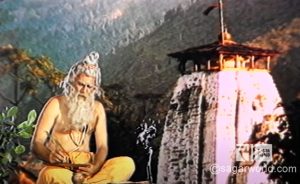
Sage Valmiki’s Ram is a human being, and the way he conducted his life, he exemplifies the ideal man, whereas Tulsidas believes Ram to be a God and devotedly bowed to him.In both these forms, Ram’s character is generous and inspiring.
The classicalpoet Kalidas was inspired by the royal character of Ram, and so he created ‘Raghuvansh Mahakavyam’. In modern times, national poet Maithili Sharan Gupta’s famous poem ‘Saket’ is focused on the luminous character of Ram.
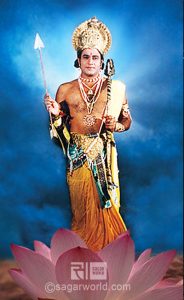
 Ram’s character will always remain an ideal in every age for the making of single faced, complete and peaceful society. As a person, Ram personifies the characteristics of an ideal person (Purshottam) who is to be emulated. He had within him all the desirable virtues that any individual would seek to aspire to, and he fulfils all his moral obligations (Maryada).
Ram’s character will always remain an ideal in every age for the making of single faced, complete and peaceful society. As a person, Ram personifies the characteristics of an ideal person (Purshottam) who is to be emulated. He had within him all the desirable virtues that any individual would seek to aspire to, and he fulfils all his moral obligations (Maryada).
Ram’s purity and piety in his intentions and actions inspires affection and devotion for him from a variety of characters from different backgrounds. For example, he gave up his rightful claim to the throne, and agreed to go into exile for fourteen years, to fulfill the vow that his father, King Dasharath, had given to Kaikeyi, his third wife.
This in spite of the fact that Kaikeyi’s son, Bharat, even begged him to return to Ayodhya, saying that he did not want to rule in place of Ram. But Ram considered his dharma as a son above that of his own birthright and his life’s ambition. For such supreme sacrifices, and many other qualities, Shri Ram is considered a Maryada Purshottam.


